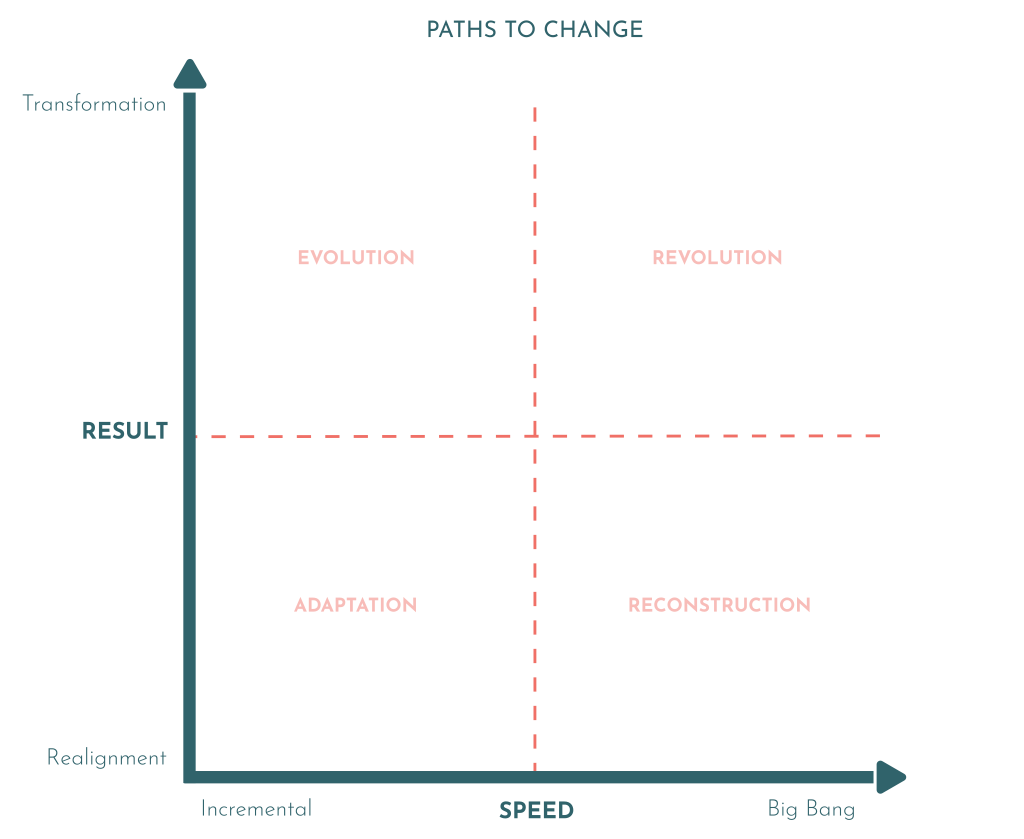July 3, 2024
No, you didn’t lead a business transformation
Transformation has become a buzzword used all too frequently by business leaders, project managers, and consultants alike. And the shorter the transformation period, the better it is. It is as if there is a vulgar sense of prestige connected to bragging about leading “big bang” business transformations.
However, as is often the case with bragging, it is exaggerated at best, not really thought through, and completely wrong at worst. Let’s get some definitions in place.
In order for something to be a transformation, it requires “a redefinition of mission and purpose, and a substantial shift in goals, to reflect a new direction and therefore encompassing a fundamental shift in the business model […] touching all cultural, structural and processual aspects,” as described by management professors Julia Balogun & Veronica Hope Hailey [1].
In other words, that implementation of a new IT system you were involved in hardly qualifies as transformation. But what was it, then?
Four different change paths
The alternative to transformation is realignment: “A change to the way of doing things that does not involve a fundamental re-appraisal of the central assumptions and beliefs within the organization, although it may still involve substantial change like a major restructuring.”
Another dimension which is a determinant for the path to change is whether change is expected (or planned) to happen incrementally or in a “big bang.” The big bang approach is popular among leaders; it signifies powerful leadership and determination, and it may appear to be the path which offers the least (or at least shortest) business interruption.
In fact, it is the opposite: A high-paced, transformative change is likely far more disrupting to the business for longer than an incremental transformation. How do you eat an elephant? One bite at a time. So why would you attempt to do it all at once, if you had the choice?
The question is, of course, which combination of speed and impact gives the best result with the lowest overall cost.
The combination of the two dimensions – speed and result – leads to four possible paths, as illustrated in the model below.
Let’s briefly explore the four paths:
- Adaptation refers to less fundamental change implemented slowly through staged initiatives.
- Reconstruction is a change undertaken to realign the way the organization operates, but in a more dramatic manner than adaptation. Often forced and reactive due to a changing competitive context.
- Evolution is transformational change implemented gradually through different stages and interrelated initiatives. Likely to be planned, proactive change undertaken in response to anticipation of the need for future change.
- Revolution is transformational change that occurs via simultaneous initiatives on many fronts, and often in a relatively short space of time. More likely to be forced and reactive, due to the changing competitive conditions the organization is facing.
The model is an adaptation of Julia Balogun and Veronica Hope Hailey (2016). Unlike Balogun and Hailey, we illustrate the two dimensions as spectrums on the two axes rather than as mutually exclusive elements, as this allows for more flexibility in real-life application of the model.
There are pros and cons with each path, but the key message here is that a revolutionary transformational approach is not the only way to change something – and it is rarely the best.
Don’t over-promise and under-deliver
To be clear, transformation is also, of course, just an everyday word commonly used to describe anything undergoing any kind of change. When the term is used in that sense; fine. But when it comes to professionally leading or managing business initiatives, more precision is needed because it sets the tactical path forward and affects how people perceive what is happening.
The latter point is exactly what is often exploited by business leaders. By talking about a smaller change as a transformation they might increase the focus on – and the perceived importance of – their initiative. Basically, it creates buy-in.
While this might be a conscious, strategic decision, it mostly leads to a case of over-promising and under-delivering. Instead, leaders would be better off showing that their carefully thought-through change path will realistically bring value to the business without unnecessary risk or cost.
In conclusion, most of what is being bragged about isn’t actually transformational at all, and those who claim to lead transformations would be wise to rethink their story. Transformations are costly, risky, lengthy, difficult, and should mostly be avoided, so if you have really driven your organization into a big bang transformation because of a new IT system, chances are you have made bad decisions for your company.
Key take-aways
Three key points to keep in mind when talking about change and transformation:
- Better alternatives to transformation: Often, there are more effective ways to achieve change and improve business outcomes than a full-blown transformation. Organizations should explore alternatives that align with their specific context and goals.
- The risk of the big bang approach: There are significant risks associated with the big bang approach to transformation. This high-impact, all-encompassing change can be disruptive and may not always yield the desired results. It is essential to weigh the risks carefully.
- Balancing ambition and pragmatism: While both transformation and the “big bang” have their place, moderation is advisable. Avoid extreme approaches on both axes simultaneously. Instead, find a balance that suits your organization’s context and capacity.
Balogun, J., Hope Hailey, V., & Gustafsson, S. (2016). Exploring Strategic Change (4th ed.)

